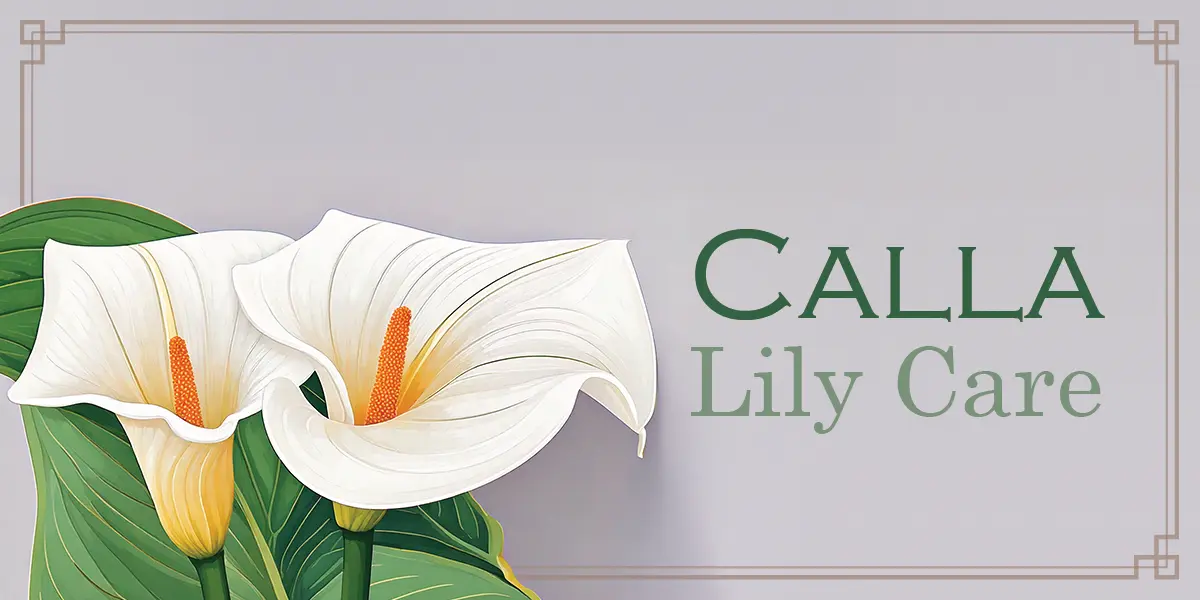It’s a lily wannabee.
The calla lily isn’t a true lily — it belongs to the Zantedeschia genus and is native to Southern Africa. Lilies, on the other hand, are members of the Lilium genus and indigenous to the temperate regions of the Northern Hemisphere.
Details, details.
Known for its elegant, trumpet-shaped flowers, the calla lily symbolizes beauty and purity. Its striking appearance, long-lasting blooms, and broad adaptability make it a favorite among gardeners and home decorators.
Southern California’s mild climate is perfect for the calla lily, but with proper care, you can enjoy these captivating flowers anywhere — even in (brrrr!) Wyoming. Just follow the guidelines below.
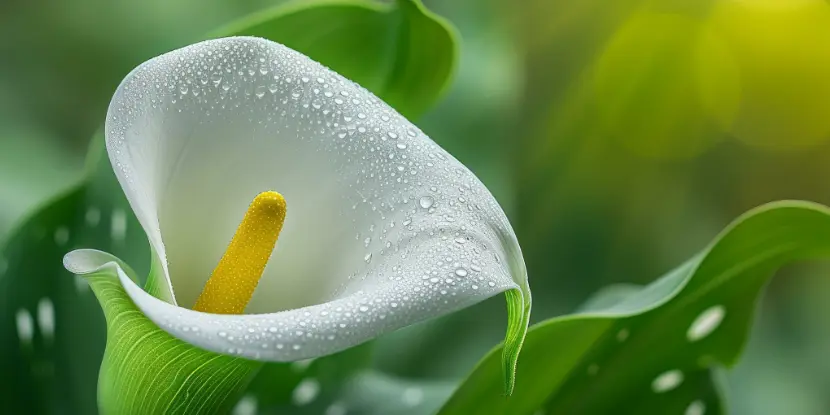
The white calla lily symbolizes purity, resurrection, and love.
Popular Types of Calla Lilies
Calla lilies come in various colors, each adding a different mood and personality to your space. Each thrives under slightly different conditions
- Classic White (Zantedeschia aethiopica): The most common variety, loved for its pure white flowers and tall green stems.
- Pink Calla Lilies (Zantedeschia rehmannii): Soft and romantic, they lend a delicate touch to a garden.
- Yellow Calla Lilies (Zantedeschia elliottiana): Vibrant and cheerful, they stand out in any outdoor setting.
- Purple/Maroons (Zantedeschia hybrids): Deep, rich hues ideal for creating dramatic, statement gardens.
Ideal Growing Conditions
Light
- Indoors: Provide 6–8 hours daily of bright, indirect sunlight. Direct sun may scorch the leaves.
- Outdoors: Position in partial shade for optimal growth. Avoid full, direct sunlight in hotter climates.
Temperature
- Calla lilies prefer temperatures between 60–75°F (15–24°C). They don’t do well in frost.
- If you’re in a cooler climate, consider planting them in pots that you can move indoors when temperatures drop.
Soil
- Rich, well-draining soil with a pH of 6.0–6.5 is ideal.
- Mix in compost or organic matter to improve drainage and provide nutrients.
- Use a potting mix formulated for bulbs or houseplants for potted calla lilies.
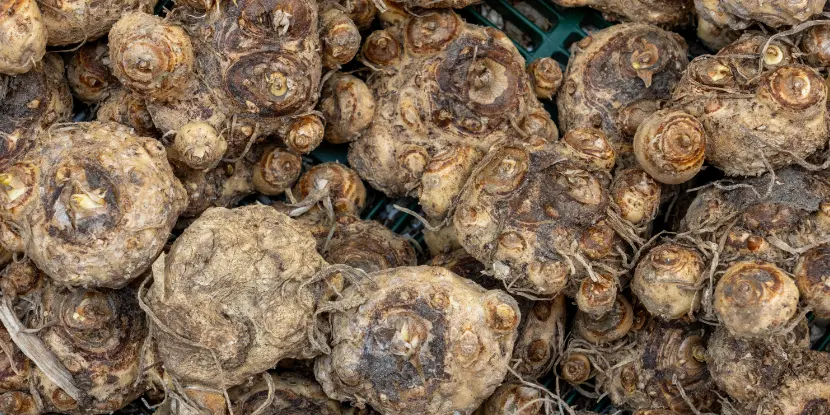
Calla lily bulbs ready for planting.
Propagating Calla Lilies
Calla lilies grow from rhizomes (bulbs) and are easy to propagate. Here’s how:
- Wait until the plant becomes dormant (usually late fall).
- Dig up the rhizomes carefully.
- Divide them into sections, ensuring each has a few healthy roots and a growing tip.
- Store in a cool, dry place until you’re ready to replant.
Planting Calla Lilies from Bulbs
Plant your calla lily bulbs in spring after the last frost, when the ground has warmed.
- Ensure the soil is loose and well-drained.
- Make holes 4 inches deep and 12 inches apart.
- Position bulbs with the growing tips facing up.
- Gently cover the bulbs with soil. Don’t compact the soil too much.
- Keep the soil moist to encourage initial growth.
Within a few weeks, you’ll start seeing green sprouts!
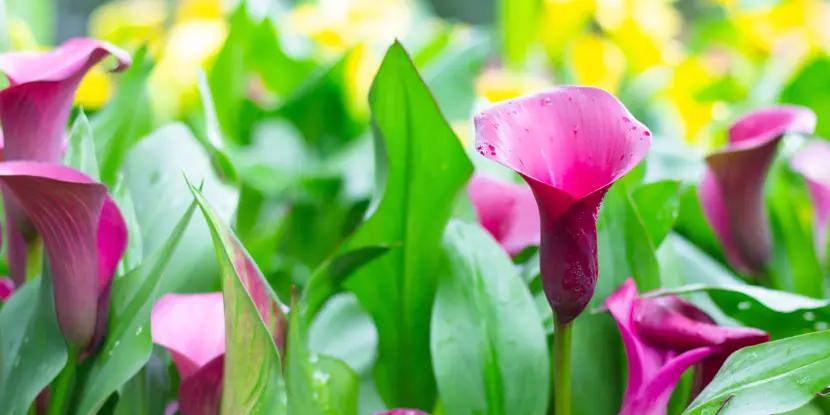
One can never have too many calla lilies, especially when they come up purple.
Growing Calla Lilies in Pots
- Pick a container with drainage holes.
- Use a potting mix with added compost.
- Plant one bulb per pot. This allows enough space for growth and prevents overcrowding.
- Fertilize monthly with a balanced liquid fertilizer.
Calla Lily Care
Watering
- Outdoors: Water deeply once a week, ensuring the soil remains moist but not soggy.
- Indoors: Check the top inch of soil — water only when dry. Adjust the frequency based on your home’s humidity.
Fertilizer
- Apply a balanced fertilizer (10-10-10) every month during the growing season.
- Avoid over-fertilizing, as it can damage the roots or leaves.
Pests & Diseases
- Common pests include aphids, spider mites, and mealybugs.
- Wipe leaves gently with a cloth dipped in soapy water, or use neem oil to manage infestations.
- Prevent diseases like root rot and powdery mildew with proper soil drainage and good airflow around your plants.
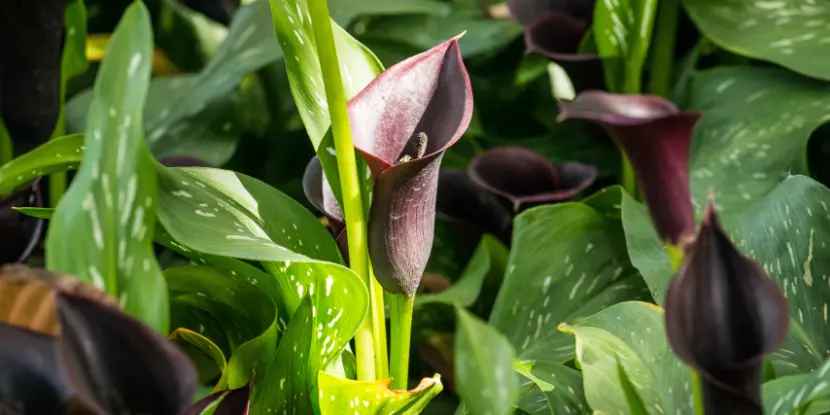
Gorgeous black calla lilies in the garden.
Pruning
- Remove spent flowers as they wilt to encourage new growth.
- Cut back leaves and stems after the first frost in fall to prepare for dormancy.
Additional Tips & Tricks
- To prolong blooming, remove yellowing leaves and spent flowers regularly.
- Avoid planting calla lilies near other bulbs that may compete for nutrients.
- If grown indoors, give your calla lily a break from blooming every few years by allowing it to go dormant in a cool, dark place for a month or two. This will rejuvenate the plant and encourage more vigorous growth.
Fun Facts about Calla Lilies
- Calla lilies aren’t true lilies but members of the Araceae family.
- The name “calla” comes from the Greek word for beauty, kallos.
- In Ancient Greece, calla lilies were associated with Venus, the goddess of love and beauty.
- In Christian symbolism, the white calla lily represents purity and resurrection.
- Calla lilies are often depicted in art and literature as symbols of femininity, grace, and innocence.
- Some cultures believe that calla lilies bring good luck and prosperity to a household.

A magnificent purple calla lily bloom.
FAQs: Calla Lily Care
Q: Why aren’t my calla lilies blooming?
This could be due to insufficient sunlight, over-fertilization, or poor-quality soil. Ensure your plant has the right balance of nutrients, light, and water.
Q: Are calla lilies poisonous?
Yes, all parts of the calla lily are toxic if ingested by humans or pets. Keep them out of reach of curious children and animals.
Q: How long do calla lily flowers last?
Calla lily blooms typically last 4–6 weeks, making them a long-lasting addition to any garden or bouquet.
Q: Can calla lilies grow in water?
While they prefer soil, calla lilies can grow hydroponically if their roots have constant access to moisture.
Q: Are calla lilies annual or perennial?
Calla lilies are perennials in warm climates but are treated as annuals or dug up and stored in cooler regions.
Q: How do I store calla lily bulbs for the winter?
After the first frost has killed off the foliage, carefully dig up the rhizomes. Rinse off any remaining soil and allow them to dry for a few days in a cool, shaded area. Store them in a paper bag or a box filled with dry peat moss in a cool, dry place until spring planting.
Q: Can calla lilies be grown indoors year-round?
Yes, calla lilies can be grown indoors year-round with adequate light, preferably 6–8 hours of bright, indirect sunlight daily. To mimic outdoor conditions, maintain consistent watering and proper humidity.
Q: What companion plants work well with calla lilies?
Calla lilies pair beautifully with plants like ferns, hostas, and astilbes in shaded gardens. For sunny spots, consider pairing them with daylilies or ornamental grasses to create texture and vibrant color contrasts.

